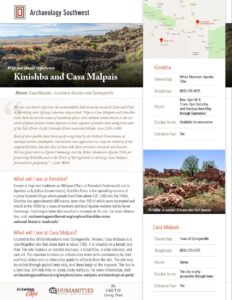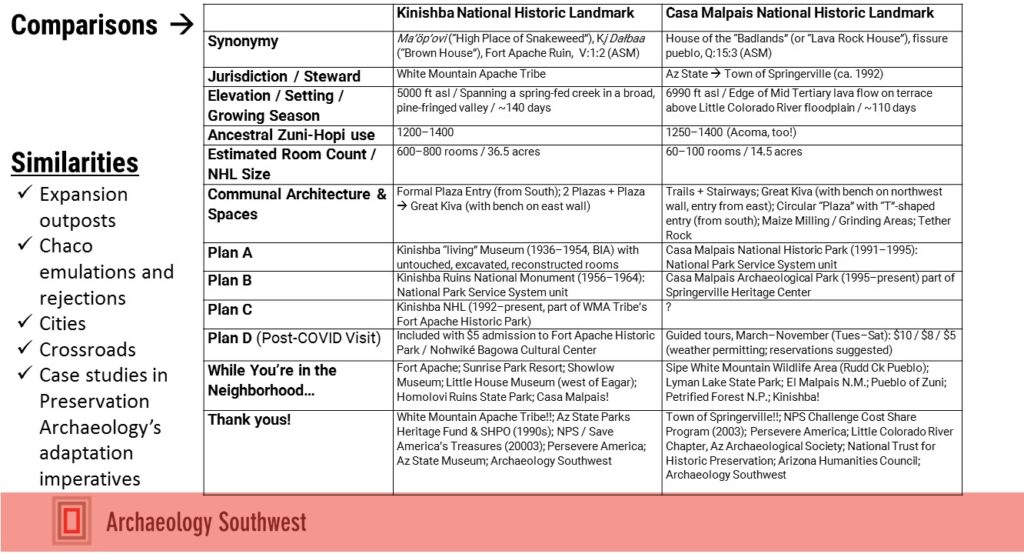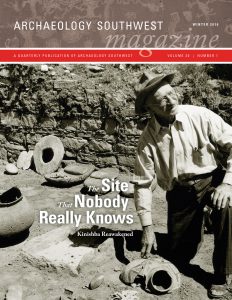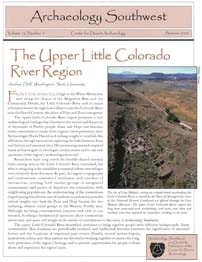Explore additional content related to A Tale of Two Cities: Casa Malpais, Kinishba, and the Elusive Promise of Archaeological Tourism, John R. Welch’s May 5, 2020 Archaeology Café Online presentation featuring Octavius Seowtewa:
Extended Q&A with John R. Welch and Octavius Seowtewa:
Q: Octavius, do you happen happen to know what day or week in June the summer dances are going to start there in Zuni? Would love to visit.
OS: The First Zuni Rain Dance of the season is scheduled for June 15–16. Because of COVID-19 concerns, we do not know yet if it will be open and there may not be an easy way to find out until about 10 days before the event.
Q: Do you think the geology influenced the location of Casa Malpais? Tell me more about the fissure at Casa Malpais.
JRW: My opinion is that the geology was a major factor affecting the placement and construction of Casa Malpais (CM). It seems likely that the village location optimizes a combination, at minimum, of (1) good views up and down the valley, (2) exposure to the warming rays of the setting sun, and (3) access to the cool storage opportunities afforded by the “fissure,” which I think is simply a big crack that occurred as the lava flow settled and eroded.
See more questions and thoughts on geology, immediately below.
Q: Was Casa Malpais built with the basalt that surrounds it? It seems like it would be difficult to cut or shape the stone.
JRW: We are not aware of any chemical studies or other analyses available to confirm or deny the supposition that CM was constructed from the most readily available stone and other materials—those more knowledgeable are most welcome to chime in—but most of the masonry appears to be made from the dominant basalt. It may also be useful to note that there are many other pueblos located in and adjacent to these mid-Tertiary lava flows, all of which seem to use local basalt. We should also bear in mind the exceptional industry and artistry of Pueblo masons. They know exactly how to shape, fit, and point pretty much any type of stone to stand time’s tests.
Q: What’s the current thinking about the so-called “catacombs” at Casa Malpais?
JRW: References to “catacombs” at CM have fallen from favor in deference to (1) lack of clear material indicators of purposeful and systematic interments, and (2) to the interests and preferences of Pueblo leaders in avoiding all sensationalizing of their ancestral homes and belongings. When asked about this matter, Mr. Seowtewa noted that some of the dead were purposefully located in and near communities to enable them to continue to provide protection and other forms of assistance to their relatives.
Q: What is the connection between Emil Haury’s theories of the Mogollon and these particular sites?
JRW: Haury was well aware of the rapid and regionally transformative expansion of Pueblo groups, primarily from the north, into the White Mountain and Mogollon Rim regions. He sometimes referred to the results of this expansion as “Anasazization.” If you are interested in reading additional discourse, consider picking up a copy of Prehistory, Personality, and Place, the good U Arizona Press book (2011) by J. Jefferson Reid and Stephanie Whittlesey. If you are, like me, more economy-minded, you can download a PDF of Charles R. Riggs’s University of Arizona open-access dissertation on the region’s Pueblo architecture here.
Q: If the Hopi and Zuni are so close historically, why are their languages so different?
JRW: We might ask the same of the French and Germans…! (Sorry to be a bit glib.) The truth is that there is an academic prize awaiting those able to identify principles that dictate any regularity in co-variations among language, culture, and genetics. We are, it turns out, a fickle species. Our collective determinations of which aspects of identity to carry forward—as opposed to which ones to consign to the middens of posterity—are fine perpetual-motion machines for brains. It may be useful to point out that, until only about a century ago, Spanish (not English, and certainly not French) was the Lingua Franca of most of rural Arizona, and that most of the great-grandparents of this generation of Native American elders were polyglots, able to communicate in various Native languages, as well as Spanish and English.
Explore Casa Malpais and Kinishba online:
For a quick overview of both sites, download our printable visitor’s guide, here (opens as a PDF).

View a comparative overview of both sites.

Learn about Kinishba:
Plan your future outing to Kinishba Ruins here.
Read Archaeology Southwest Magazine (Vol. 30, No. 1), “The Site That Nobody Really Knows: Kinishba Reawakened,” available as a free PDF download through May 31, 2020, here.

For further reading:
Welch, J.R. (2007) ‘A Monument to Native Civilization’: Byron Cummings’ Still-Unfolding Vision for Kinishba Ruins. Journal of the Southwest 49 (1):1–94.
Download as a PDF
Welch, J.R. (2007) Kinishba Bibliography. Journal of the Southwest 49(1):117–127.
Download as a PDF
Welch, J.R., Editor (2013) Kinishba Lost and Found: Mid-Century Excavations and Contemporary Perspectives. Arizona State Museum Archaeological Series 206, University of Arizona, Tucson.
Available for purchase here
Learn about Casa Malpais:
Plan your future outing to Casa Malpais Archaeological Park here.
Learn about Archaeology Southwest’s past stabilization work at Casa Malpais here, and watch a short video, with drone photography by Douglas Gann, about these efforts below:
Read about Casa Malpais in Archaeology Southwest Magazine (Vol. 16, No. 3), “The Upper Little Colorado River Region,” available as a free download here.

Explore more by John R. Welch:
Welch, J.R., and T. J. Ferguson (2007) Putting Patria into Repatriation: Cultural Affiliations of White Mountain Apache Tribe Lands. Journal of Social Archaeology 7:171–198.
Download as a PDF
Watch “The White Mountain Apache Experiment in Community-Based Site Protection” below:
Watch “Placemaking and Displacement at Fort Apache and Theodore Roosevelt School” below:
To stay informed about future online presentations and video releases, join our email list below:
Sign Up for Emails